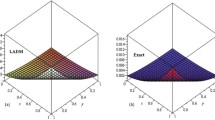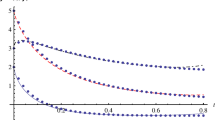Abstract
In many recent works, many authors have demonstrated the usefulness of fractional calculus in the derivation of particular solutions of a significantly large number of linear ordinary and partial differential equations of the second and higher orders. The main objective of the present paper is to show how this simple fractional calculus method to the solutions of some families of fractional differential equations would lead naturally to several interesting consequences, which include (for example) a generalization of the classical Frobenius method. The methodology presented here is based chiefly upon some general theorems on (explicit) particular solutions of some families of fractional differential equations with the Laplace transform and the expansion coefficients of binomial series.
MSC:26A33, 33C10, 34A05.
Similar content being viewed by others
1 Introduction, definitions and preliminaries
In the past two decades, the widely investigated subject of fractional calculus has remarkably gained importance and popularity due to its demonstrated applications in numerous diverse fields of science and engineering. These contributions to the fields of science and engineering are based on the mathematical analysis. It covers the widely known classical fields such as Abel’s integral equation and viscoelasticity. Also, including the analysis of feedback amplifiers, capacitor theory, generalized voltage dividers, fractional-order Chua-Hartley systems, electrode-electrolyte interface models, electric conductance of biological systems, fractional-order models of neurons, fitting of experimental data, and the fields of special functions, etc. (see, for example, [1–4]).
In this paper, we apply the Laplace of the fractional derivative and the expansion coefficients of binomial series to derive the explicit solutions to homogeneous fractional differential equations.
We present some useful definitions and preliminaries as follows.
Definitions
where the Euler gamma function is defined by
-
2.
The Laplace transform of a function , is defined by
-
3.
The Mittag-Leffler function (cf. [5, 6]) is defined by
-
4.
The simplest Wright function (cf. [7, 8]) is defined by
-
5.
The general Wright function (cf. [7, 8]) is defined for , complex , and real (; ) by the series
where , , and .
-
6.
The Riemann-Liouville fractional derivatives and of order () are defined by
(1.1)
and
respectively, where means the integral part of .
-
7.
The Pochhammer symbol (or the shifted factorial, since for ) (cf. [9]) given by
-
8.
The binomial coefficients are defined by
where λ and n are integers. Observe that , then
Preliminaries
-
1.
(, ; ).
-
2.
The Laplace transform of the generalized Wright function is given by
-
3.
(cf. [10]), where , (), , for any .
Remark 1.1 By appropriately appealing to Definition 2, it is not difficult to prove Preliminary 3 by the technique of integral transform as follows
The interchange of the order of integration in the above derivation can be justified by applying Fubini’s theorem.
2 Solutions of the fractional differential equations
Throughout this section, we let be such that for some value of the parameter s, the Laplace transform converges.
Theorem 2.1 Let and . Then the fractional differential equation
with the initial conditions and has its solution given by
Proof Applying the Laplace transform (see Preliminary 3) and taking into account, we have
Equation (2.3) yields
since
Thus, from Equation (2.4), we derive the following solution by the inverse Laplace transform to Equation (2.2):
□
Example 2.1 The fractional differential equation of a generalized viscoelastic free damping oscillation (cf. [1])
with the initial conditions and has its solution given by
In particular, if and , then the equation
with the initial conditions and has its solution given by
Theorem 2.2 Let and . Then the fractional differential equation
with the initial conditions and has its solution given by
Proof Applying the Laplace transform (see Preliminary 3) and taking into account, we have
That is,
Equation (2.12) yields
since
Thus, from Equation (2.13), we derive the following solution by the inverse Laplace transform to Equation (2.11):
This solution can be expressed by the Wright function as
□
Example 2.2 If we let , and in Theorem 2.2, then the equation
has a solution
Theorem 2.3 Let and . Then the equation
with the initial condition has its solution given by
Proof Applying the Laplace transform to Equation (2.15), that is,
we have
□
Remark 2.1 If in Equation (2.10), then the equation
with the initial conditions and has its solution given by
Theorem 2.4 A nearly simple harmonic vibration equation (cf. [1])
with the initial conditions and has its solution given by
Proof We complete this proof by putting in Equation (2.17). □
In fact, by applying the Laplace transform to a linear fractional differential equation with the initial conditions, we can easily derive its solutions as the previous forms in this paper.
References
Gorenflo R, Mainardi F, Srivastava HM: Special functions in fractional relaxation-oscillation and fractional diffusion-wave phenomena. In Proceedings of the Eighth International Colloquium on Differential Equations. Edited by: Bainov D. VSP Publishers, Utrecht; 1998:195-202. Presented at the Eighth International Colloquium on Differential Equations held at Plovdiv, Bulgaria, 18-23 August 1997
Hilfer R: Applications of Fractional Calculus in Physics. World Scientific, Singapore; 2000.
Kilbas AA, Srivastava HM, Trujillo JJ: Theory and Applications of Fractional Differential Equations. Elsevier, Amsterdam; 2006.
Mainardi F: The fundamental solutions for the fractional diffusion-wave equation. Appl. Math. Lett. 1996, 9(6):23-28. 10.1016/0893-9659(96)00089-4
Mittag-Leffler G:Sur la nouvelle fonction . C. R. Acad. Sci. 1903, 137: 554-558.
Tomovski Z, Hilfer R, Srivastava HM: Fractional and operational calculus with generalized fractional derivative operators and Mittag-Leffler type functions. Integral Transforms Spec. Funct. 2010, 21: 797-814. 10.1080/10652461003675737
Erdélyi A, Magnus W, Oberhettinger F, Tricomi F 3. In Higher Transcendental Functions. Krieger, Melbourne; 1981.
Srivastava HM, Parmar RK, Chopra P: A class of extended fractional derivative operators and associated generating relations involving hypergeometric functions. Axioms 2012, 1(3):238-258. 10.3390/axioms1030238
Lin S-D, Chang L-F, Srivastava HM: Some families of series identities and associated fractional differintegral formulas. Integral Transforms Spec. Funct. 2009, 20(10):737-749. 10.1080/10652460902782354
Caputo M: Elasticita e Dissipazione. Zanichelli, Bologna; 1969.
Acknowledgements
Dedicated to Professor Hari M Srivastava.
The present investigation was supported, in part, by the National Science Council of the Republic of China under Grant NSC-101-2115-M-033-002.
Author information
Authors and Affiliations
Corresponding author
Additional information
Competing interests
The authors declare that they have no competing interests.
Authors’ contributions
S-DL carried out the molecular genetic studies, participated in the sequence alignment and drafted the manuscript. C-HL participated in the sequence alignment.
Rights and permissions
Open Access This article is distributed under the terms of the Creative Commons Attribution 2.0 International License (https://creativecommons.org/licenses/by/2.0), which permits unrestricted use, distribution, and reproduction in any medium, provided the original work is properly cited.
About this article
Cite this article
Lin, SD., Lu, CH. Laplace transform for solving some families of fractional differential equations and its applications. Adv Differ Equ 2013, 137 (2013). https://doi.org/10.1186/1687-1847-2013-137
Received:
Accepted:
Published:
DOI: https://doi.org/10.1186/1687-1847-2013-137




